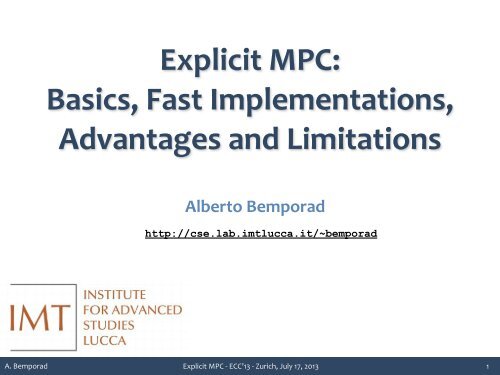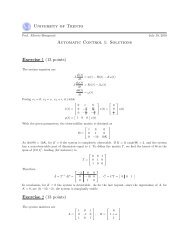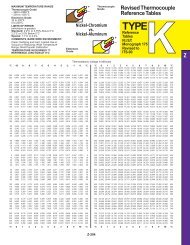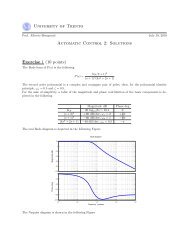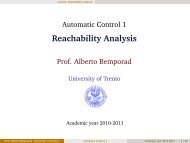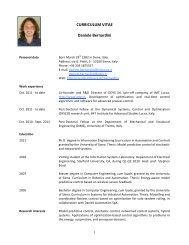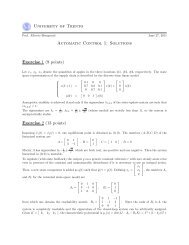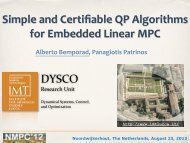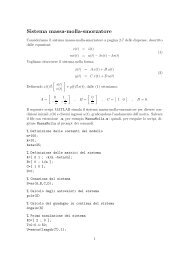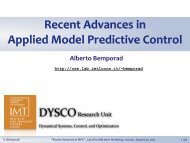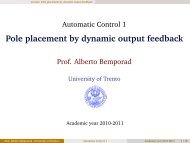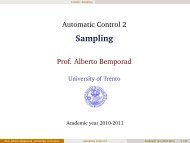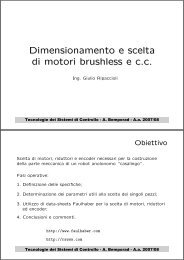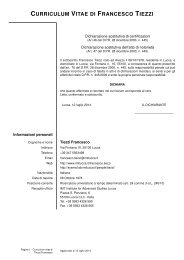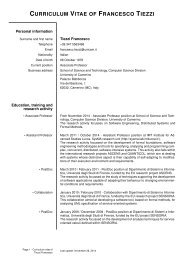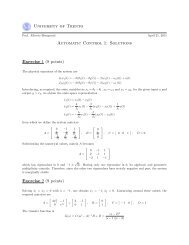Explicit MPC: Basics, Fast Implementations, Advantages and ...
Explicit MPC: Basics, Fast Implementations, Advantages and ...
Explicit MPC: Basics, Fast Implementations, Advantages and ...
You also want an ePaper? Increase the reach of your titles
YUMPU automatically turns print PDFs into web optimized ePapers that Google loves.
<strong>Explicit</strong> <strong>MPC</strong>:<br />
<strong>Basics</strong>, <strong>Fast</strong> <strong>Implementations</strong>, <br />
<strong>Advantages</strong> <strong>and</strong> Limitations<br />
Alberto Bemporad<br />
http://cse.lab.imtlucca.it/~bemporad<br />
A. Bemporad <strong>Explicit</strong> <strong>MPC</strong> -‐ ECC’13 -‐ Zurich, July 17, 2013 1
Outline<br />
• Formulation of linear <strong>MPC</strong> design framework<br />
• Multiparametric quadratic programming (explicit <strong>MPC</strong>)<br />
• An automotive control example<br />
• <strong>Fast</strong> circuit implementations<br />
• Final conclusions (explicit vs implicit <strong>MPC</strong>)<br />
A. Bemporad <strong>Explicit</strong> <strong>MPC</strong> -‐ ECC’13 -‐ Zurich, July 17, 2013<br />
2
Finite-‐time optimal control of linear systems<br />
linear model<br />
<br />
xk+1 = Ax k + Bu k<br />
performance index<br />
y k = Cx k<br />
z =<br />
min x u 0 ,...,u N−1<br />
N Px N +<br />
N−1 <br />
k=0<br />
x k Qx k + u k Ru k<br />
min<br />
2 z Hz + x 0 F z + 1 2 x 0 Yx 0<br />
s.t. Gz ≤ W + Sx 0<br />
z<br />
1<br />
H 0<br />
⎡<br />
⎢<br />
⎣<br />
⎤<br />
u 0<br />
u 1<br />
⎥<br />
. ⎦<br />
u N−1<br />
constraints <br />
<br />
umin ≤ u k ≤ u max<br />
y min ≤ Cx k ≤ y max<br />
(convex) Quadratic Program (QP)<br />
A. Bemporad <strong>Explicit</strong> <strong>MPC</strong> -‐ ECC’13 -‐ Zurich, July 17, 2013<br />
3
Linear <strong>MPC</strong> algorithm<br />
@ each sampling step t:<br />
past<br />
future<br />
y k<br />
r(t)<br />
predicted outputs<br />
u k<br />
manipulated<br />
inputs<br />
t t+k t+N<br />
•Measure (or estimate) the current state x(t) <br />
feedback !<br />
• Get the solution z * ={u 0<br />
*,...,u N-1 * } of the QP<br />
min z<br />
s.t.<br />
1<br />
2<br />
z Hz + x (t)F z<br />
Gz ≤ W + Sx(t)<br />
• Apply only u(t)= u 0<br />
*, discard remaining optimal inputs u 1<br />
*,...,u N-1 *<br />
Routinely used in process control, now spreading in automotive/aerospace<br />
A. Bemporad <strong>Explicit</strong> <strong>MPC</strong> -‐ ECC’13 -‐ Zurich, July 17, 2013 4
Requirements for embedded <strong>MPC</strong><br />
1. Speed: fast enough to provide a solution within <br />
short sampling intervals (such as 10-‐100 ms)<br />
2.Require simple/cheap hardware (microcontroller, <br />
microprocessor, FPGA) <strong>and</strong> little memory to store <br />
problem data <strong>and</strong> code<br />
3.Code simple enough to be verifiable/certifiable<br />
4.Worst-‐case execution time must be (tightly) estimated for <br />
embedding <strong>MPC</strong> in a real-‐time platform<br />
A. Bemporad <strong>Explicit</strong> <strong>MPC</strong> -‐ ECC’13 -‐ Zurich, July 17, 2013<br />
5
Computing the <strong>MPC</strong> comm<strong>and</strong> action<br />
Algorithms for solving QP on-‐line given x(t):<br />
min z<br />
1<br />
2<br />
z Hz + x (t)F z<br />
• active set (AS) methods<br />
• interior point (IP) methods<br />
• gradient projection (GP) methods <br />
• conjugate gradient (CG) methods<br />
• alternating direction method of multipliers (ADMM)<br />
s.t. Gz ≤ W + Sx(t)<br />
Quadratic Program (QP)<br />
(the control law u=u(x) is implicitly defined by the QP solver) <br />
Alternative: solve the QP off-‐line for all x(t) to find the control law <br />
u=u(x) explicitly via multiparametric programming <br />
A. Bemporad <strong>Explicit</strong> <strong>MPC</strong> -‐ ECC’13 -‐ Zurich, July 17, 2013<br />
6
Offline multiparametric QP algorithm<br />
Fix a point x 0 2 X in the parameter space<br />
solve QP to find<br />
z ∗ (x 0 ), λ ∗ (x 0 )<br />
identify active constraints at<br />
form matrices <br />
active constraints:<br />
˜G, ˜W , ˜S<br />
z ∗ (x 0 )<br />
by collecting<br />
˜Gz ∗ (x 0 ) − ˜W − ˜Sx 0 =0<br />
(Bemporad, Morari, Dua, Pistikopoulos, 2002)<br />
min z<br />
s.t.<br />
1<br />
2<br />
z Hz + x F z<br />
Gz ≤ W + Sx<br />
KKT <br />
optimality<br />
conditions:<br />
(1) Hz + Fx+ G λ = 0 (2) ˜Gz − ˜W − ˜Sx =0<br />
(3) λ i (G i z − W i − S i x) = 0 (4) Ĝz ≤ Ŵ + Ŝx<br />
(5) ˜λ i ≥ 0, ˆλ i =0<br />
From (1) : <br />
z = −H −1 (Fx+ ˜G ˜λ)<br />
From (2) : <br />
z(x) =H −1 ˜G ( ˜GH −1 ˜G ) −1 ( ˜W +(˜S + ˜GH −1 F )x) − Fx <br />
In some neighborhood of x 0 , λ <strong>and</strong> z are explicit affine functions of x<br />
(Zafiriou, 1990)<br />
A. Bemporad <strong>Explicit</strong> <strong>MPC</strong> -‐ ECC’13 -‐ Zurich, July 17, 2013<br />
7
Multiparametric QP algorithm<br />
• Impose primal <strong>and</strong> dual feasibility:<br />
Ĝz(x) ≤ Ŵ + Ŝx<br />
˜λ(x) ≥ 0<br />
from (4)<br />
from (5)<br />
CR 0<br />
linear inequalities in x !<br />
x-‐space<br />
• Remove redundant constraints (this requires solving LP’s):<br />
critical region CR 0<br />
• x<br />
0<br />
X<br />
• CR 0 is the set of all <strong>and</strong> only parameters x for which <br />
combination of active constraints at the optimizer<br />
is the optimal <br />
A. Bemporad <strong>Explicit</strong> <strong>MPC</strong> -‐ ECC’13 -‐ Zurich, July 17, 2013<br />
8
Multiparametric QP solvers<br />
Method #1: Split <strong>and</strong> proceed iteratively <br />
(Bemporad, Morari, Dua, Pistikopoulos, 2002)<br />
Method #2: Split <strong>and</strong> proceed iteratively <br />
(Tøndel, Johansen, Bemporad, 2003)<br />
x-‐space<br />
R 2<br />
R • x 1 0<br />
CR 0<br />
R 3<br />
CR 1<br />
R N R 4<br />
X<br />
add constraint #i<br />
CR 0<br />
CR 0<br />
CR 0<br />
Ĝ i z(x) ≤ Ŵ i + Ŝ i x<br />
˜λ j (x) ≥ 0<br />
remove constraint #j <br />
Method #3: exploit the facet-‐to-‐facet property<br />
(Spjøtvold, Kerrigan, Jones, Tøndel, Johansen, 2006) (Spjøtvold, 2008)<br />
Step out ² outside each facet, solve QP, get new region, iterate. (Baotic, 2002)<br />
A. Bemporad <strong>Explicit</strong> <strong>MPC</strong> -‐ ECC’13 -‐ Zurich, July 17, 2013<br />
9
Properties of multiparametric QP<br />
z ∗ : X ∗ → R s<br />
(Bemporad, Morari, Dua, Pistikopoulos, 2002)<br />
z ∗ (x) =argmin z<br />
s.t.<br />
1<br />
2<br />
x Hz + x F z<br />
Gz ≤ W + Sx<br />
continuous,<br />
piecewise affine <br />
V ∗ (x) = 1 2 x Yx+min z<br />
s.t.<br />
1<br />
2<br />
x Hz + x F z<br />
Gz ≤ W + Sx<br />
convex, continuous, <br />
piecewise quadratic, <br />
C 1 (if no degeneracy)<br />
Corollary: The linear <strong>MPC</strong> controller is a continuous piecewise affine <br />
function of the state<br />
z ∗ =<br />
⎡<br />
⎢<br />
⎣<br />
u ∗ 0<br />
u ∗ 1<br />
.<br />
u ∗ N−1<br />
⎤<br />
⎥<br />
⎦<br />
A. Bemporad <strong>Explicit</strong> <strong>MPC</strong> -‐ ECC’13 -‐ Zurich, July 17, 2013<br />
10
Applicability of explicit <strong>MPC</strong> approach<br />
• Consider the following general <strong>MPC</strong> formulation<br />
min z<br />
N−1 <br />
k=0<br />
1<br />
2 (y k − r(t + k) S(y k − r(t + k))+ 1 2 ∆u k T ∆u k<br />
+(u k − u r (t + k)) V (u k − u r (t + k)) + ρ 2<br />
subj. to x k+1 = Ax k + Bu k + B v v(t + k), k =0,...,N − 1<br />
y k = Cx k + Du k + D v v(t + k), k =0,...,N − 1<br />
u min (t + k) ≤ u k ≤ u max (t + k), k =0,...,N − 1<br />
∆u min (t + k) ≤ ∆u k ≤ ∆u max (t + k), k =0,...,N − 1<br />
y min (t + k) − V min ≤ y k ≤ y max (t + k) + V max , k =1,...,N<br />
• Everything marked in red can be time-‐varying in explicit <strong>MPC</strong><br />
• Not applicable to time-‐varying problems (weights <strong>and</strong>/or system matrices)<br />
• Can be extended to hybrid systems (continuity of control law may be lost)<br />
(Bemporad, Borrelli, Morari, 2001) (Mayne, Rakovic, 2002) (Mayne, ECC 2001)<br />
(Borrelli, Baotic, Bemporad, Morari, 2005) (Alessio, Bemporad, 2006)<br />
A. Bemporad <strong>Explicit</strong> <strong>MPC</strong> -‐ ECC’13 -‐ Zurich, July 17, 2013<br />
11
Hybrid Toolbox for MATLAB<br />
Features:<br />
• <strong>Explicit</strong> <strong>MPC</strong> control (via multi-‐parametric programming)<br />
<strong>and</strong> C-‐code generation<br />
(Bemporad, 2003-‐2013)<br />
Supported by<br />
• Hybrid models: design, simulation, verification<br />
5000+ download requests<br />
since October 2004<br />
http://cse.lab.imtlucca.it/~bemporad/hybrid/toolbox/<br />
Other good tools: Multiparametric Toolbox (see next talk !)<br />
A. Bemporad <strong>Explicit</strong> <strong>MPC</strong> -‐ ECC’13 -‐ Zurich, July 17, 2013<br />
12
<strong>Explicit</strong> <strong>MPC</strong> for idle speed control<br />
(Di Cairano, Yanakiev, Bemporad, Kolmanovsky, Hrovat, 2011)<br />
• Ford pickup truck, V8 4.6L gasoline engine<br />
• Process:<br />
-‐ 1 output (engine speed) to regulate<br />
-‐ 2 inputs (airflow, spark advance)<br />
-‐ input delays<br />
• Objectives <strong>and</strong> specs:<br />
-‐ regulate engine speed at constant rpm<br />
-‐ saturation limits on airflow <strong>and</strong> spark<br />
-‐ lower bound on engine speed (≥450 rpm)<br />
A. Bemporad <strong>Explicit</strong> <strong>MPC</strong> -‐ ECC’13 -‐ Zurich, July 17, 2013<br />
13
<strong>Explicit</strong> <strong>MPC</strong> for idle speed -‐ Experiments<br />
(Di Cairano, Yanakiev, Bemporad, Kolmanovsky, Hrovat, 2011)<br />
• Sampling time = 30 ms<br />
• <strong>Explicit</strong> <strong>MPC</strong> implemented in dSPACE <br />
MicroAutoBox rapid prototyping unit<br />
Load torque (power steering)<br />
• Observer tuning as much important<br />
as tuning of <strong>MPC</strong> weights !<br />
peak reduced by 50%<br />
convergence 10s faster<br />
explicit <strong>MPC</strong><br />
baseline controller (linear)<br />
set-‐point<br />
A. Bemporad <strong>Explicit</strong> <strong>MPC</strong> -‐ ECC’13 -‐ Zurich, July 17, 2013<br />
14
Hardware (ASIC) implementation of explicit <strong>MPC</strong><br />
http://www.mobydic-project.eu/<br />
A. Bemporad <strong>Explicit</strong> <strong>MPC</strong> -‐ ECC’13 -‐ Zurich, July 17, 2013<br />
15
continuous functions that are affine over each simplex constitutes an N v -dim<br />
PWA approximation of <strong>MPC</strong> over simplices<br />
P W AS[S] ⊂ PWA[S] ∩ C 0 [S] [19]. Therefore, it is possible to define diffe<br />
• Approximate<br />
independent<br />
a <br />
functions<br />
given linear<br />
belonging<br />
<strong>MPC</strong> controller<br />
to P W<br />
by<br />
AS<br />
using canonical PWA functions <br />
p [S]. By choosing some (arbitrary<br />
over simplicial partitions (PWAS)<br />
(Bemporad, Oliveri, Poggi, Storace , 2011)<br />
these bases, we can regard them as an N v -length vector, say φ(x). Then a sca<br />
is defined as a linear combination of the basis functions as follows<br />
û(x) =<br />
N v<br />
k=1<br />
w k φ k (x) =w φ(x)<br />
Vector w =[w 1 ... w Nv ] determines û uniquely for each given x ∈ S.<br />
approximate <strong>MPC</strong> law<br />
(Julian, Desages, Agamennoni, 1999)<br />
Weights wk optimized off-‐line <br />
to best approximate a given <strong>MPC</strong> law<br />
September 29, 2010<br />
http://www.mobydic-project.eu/<br />
A. Bemporad <strong>Explicit</strong> <strong>MPC</strong> -‐ ECC’13 -‐ Zurich, July 17, 2013<br />
16
PWA approximation of <strong>MPC</strong> over simplices<br />
• Extremely cheap: PWAS functions can be directly implemented <br />
on FPGA, or ASIC (Application Specific Integrated Circuits)<br />
• Extremely fast computations (10-‐100 nanoseconds)<br />
Computation time [s] Control M p Latency Computation (A - B) time [ns] [s] M Latency online time<br />
fit criterion<br />
(A - B) [ns]<br />
12 0.18187 170 -12 31<br />
0.1818 to compute 170 - 31 <strong>MPC</strong><br />
36 L 2 0.046131 238 -36 45<br />
0.0461 238 - 45<br />
Architecture A: (Xilinx Spartan 3 FPGA)<br />
170 0.022963 272 -170 46 mainly 0.0229 serial 272 - 46<br />
11 0.16797 170 -11 31<br />
0.1679 170 - 31<br />
34 L ∞ Architecture B: MIMO system dynamics<br />
0.046131 238 -34 45<br />
0.0461 238 - 45<br />
fully parallel<br />
1.2 1<br />
160 0.022763 272 -160 46<br />
0.0227 x k+1 = 272 - 46x k +<br />
# partitions<br />
per dimension<br />
Exact explicit <strong>MPC</strong>: 52 regions <br />
383 ns (avg) -‐ 486 ns (max)<br />
y k =<br />
0 1.1<br />
1 1<br />
x<br />
1 0 k<br />
<br />
0 1<br />
u<br />
1 1 k<br />
subject to saturation on u <strong>and</strong> y<br />
• Closed-‐loop stability results are available<br />
(Bemporad, Oliveri, Poggi, Storace , 2011)<br />
(Rubagotti, Barcelli, Bemporad, 2012)<br />
✖Curse of dimensionality (with respect to to state dimension)<br />
A. Bemporad <strong>Explicit</strong> <strong>MPC</strong> -‐ ECC’13 -‐ Zurich, July 17, 2013<br />
17
Complexity of multiparametric solutions<br />
•The number of regions depends on the number of <br />
possible combinations of active constraints<br />
•Weak dependence on the number of states <strong>and</strong> references<br />
•<strong>Explicit</strong> <strong>MPC</strong> gets less attractive when number of regions grows,<br />
too much memory required, too much time to locate state x(t)<br />
•<strong>Fast</strong> <strong>and</strong> simple on-‐line QP may be preferable otherwise<br />
<br />
A. Bemporad <strong>Explicit</strong> <strong>MPC</strong> -‐ ECC’13 -‐ Zurich, July 17, 2013 18
<strong>Fast</strong> gradient projection for (dual) QP<br />
• Solve dual QP using fast gradient projection<br />
(Nesterov, 1983)<br />
• Main on-‐line operations involve only <br />
simple linear algebra<br />
• Using Riccati-‐like iterations, complexity <br />
per iteration is O(N) [N = prediction horizon]<br />
(Patrinos, Bemporad, IEEE TAC, 2013)<br />
• Tight bounds on maximum number of iterations<br />
• Similar approaches exist<br />
(Richter, Morari, Jones, 2009/2011/2012)<br />
(Giselsson, 2012)<br />
• Dual gradient projection methods for QP work very well in fixed-‐point !<br />
(Patrinos, Guiggiani, Bemporad, ECC 2013)<br />
A. Bemporad <strong>Explicit</strong> <strong>MPC</strong> -‐ ECC’13 -‐ Zurich, July 17, 2013<br />
19
Conclusions<br />
<strong>Explicit</strong> or implicit <br />
CPU time / throughput<br />
worst-‐case exec estimates<br />
numerical arithmetics<br />
off-‐line computations<br />
solution quality (feas/opt)<br />
data memory<br />
control code<br />
<strong>Explicit</strong><br />
<strong>MPC</strong><br />
Implicit (=on-‐line QP)<br />
active <br />
set<br />
interior <br />
point<br />
gradient<br />
projection<br />
problem size small medium large medium<br />
•<strong>Explicit</strong> typically limited 6÷8 free control moves <strong>and</strong> 8÷12 parameters <br />
(states+references)<br />
•Embedded QP methods are preferable otherwise<br />
A. Bemporad <strong>Explicit</strong> <strong>MPC</strong> -‐ ECC’13 -‐ Zurich, July 17, 2013<br />
20
Conclusions<br />
Research on QP solution methods started ~60 years ago ...<br />
(Beale, 1955)<br />
... still more research on QP can have an impact in real applications !<br />
A. Bemporad <strong>Explicit</strong> <strong>MPC</strong> -‐ ECC’13 -‐ Zurich, July 17, 2013<br />
21


